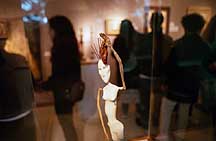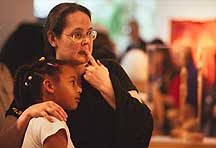(Published May 29, 2001)
After reviewing artwork that included silhouettes of fallen bodies,
strewn with trash and dead leaves, a diverse crowd packed Grant Hall's
theater Thursday night at Alaska Pacific University. The event, "Ceremony
of Healing: Expressions Concerning Violence Toward Alaska Native Women,"
was intended to spark dialogue about a recent spate of unsolved murders in
Anchorage and also to speak to the value of lost sisters.

"What Does It Take for You To See My Heart?" is a work by
Susie Silook on display in the "Ceremony of Healing" exhibit in
Grant Hall at Alaska Pacific University. (Photo by Marc Lester /
Anchorage Daily News)
|
"You need to see
the humanity behind what's going on," said Susie Silook, an artist who has
spoken publicly about a sexual assault she survived in 1999.
Silook's outrage about brutalities visited on Native women was echoed
by other speakers and artists who relayed personal stories about
molestation, rape and racism. Some spoke about a frustration to be heard
and a history of cultural apartheid.
In an essay, writer Martha Upicksoun recalled a first youthful
awareness of violence -- the murder of a young Native woman. Upicksoun
spoke of how decades later, painful as it was, she contacted the murdered
woman's family to re-examine the death. In learning their memories of the
victim, Upicksoun was struck by two things: how the death had deeply
touched each member of the woman's family, and how it seemed nobody else
cared.

Anna Upicksoun and her daughter Aunalisa Fox look at artwork
by Phyllis Ann Fast during the opening of the "Ceremony of Healing"
exhibit. (Photo by Marc Lester / Anchorage Daily
News)
|
The evening's defining moment
came when an unruly, seemingly inebriated woman staggered into the
auditorium, loudly creating a scene. An uncomfortable silence fell over
the room as the woman, her face hidden by a headband and long hair, pushed
away an organizer and an Anchorage police officer who tried to escort her
out.
When the woman took the stage and picked up a script, the audience
realized it had been had. The crasher was Diane Benson, a writer and
actor, who launched into a catalog of work that addressed identity and
respect. Benson's message was unmistakable as she gingerly slipped on
beaded moccasins and humanized the "drunk" by unveiling her, inviting the
audience to discard a stereotype.
In a performance piece that struggled to convey a horrific rape to
unwilling readers in a creative-writing class, Benson said she only sought
to speak the truth, because to be silent "makes you crazy."
"Ceremony of Healing" was starkly painful, disturbing and laced with
anger but also held elements of hope and community solidarity. After the
event, some visitors dropped beads into a glass jar in a ritualistic and
symbolic purging.

Diane Benson speaks as "the writer" in "Would It Be Too
Much," a dialogue about the experience of rape. (Photo by Marc
Lester / Anchorage Daily News)
|
As the
evening closed, patrons lingered to study the artwork, especially an
exhibit by Silook that included transcripts from a police investigation of
her rape.
In her piece called "Shadow of Death," Susie Bevins memorialized Native
women "valued by their creator who formed them while yet in their mother's
womb, fearfully and wonderfully made. Loved by their families and friends.
They were of great value."
Reporter Sandi Gerjevic can be reached at sgerjevic@adn.com.
![]()
![]()


